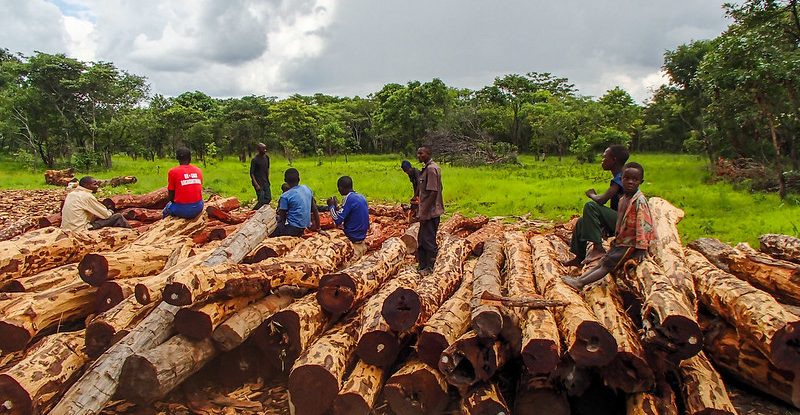
Saving endangered species is a critical challenge for conservation and sustainability movements, and is also a matter of survival as biodiversity provides livelihoods for many communities worldwide. According to an Intergovernmental Science-Policy Platform on Biodiversity and Ecosystem Services (IPBES) report, we are facing an extinction crisis. While habitat degradation associated with large-scale land use change is a key driver of biodiversity and species loss, the overexploitation of wildlife – including the illegal wildlife and plant trades and related biosecurity risks – is also a significant contributor.
In 1973, a global Convention on International Trade in Endangered Species of Wild Fauna and Flora (CITES) was adopted. Historically, tropical tree species have not featured strongly amongst the species listed in the Convention, but emphasis in this arena has grown in recent years. A new book published by Cambridge University Press, CITES As a Tool for Sustainable Development (which is summarized in a brief by the Center for International Forestry Research and World Agroforestry (CIFOR-ICRAF), includes several tree species as case studies to examine the effectiveness of CITES implementation towards achieving the Sustainable Development Goals (SDGs). It finds that while considerable progress has been made, more must be done to protect species from extinction through international trade.
The story of CITES
After over a decade of negotiations and meetings, ten states agreed upon the Convention on International Trade in Endangered Species of Wild Fauna and Flora (CITES) at the Washington Convention in 1973. Half a century later, CITES has 183 contracted state parties, as well as the European Union. Signatories must adapt their legislation – or adopt new legislation – to meet specific criteria, including designating a scientific and management authority, prohibiting trade in violation of the Convention, penalizing trade violations, and providing for the confiscation of illegally traded and possessed animals and plants.
CITES lists species that are at risk from trade in three appendices, for which graduated controls are required depending on the level of threat. Appendix I denotes those that are endangered, can only be traded in exceptional circumstances and require both import and export permits; Appendix II represents those that can be traded subject to regulation, which is often based on agreed annual quotas and export permits; and Appendix III is a unilateral listing for which trade controls are relatively minimal.
Implementation of the Convention has its challenges. Each signatory must roll it out amidst a complex array of local, regional, national, and international administrative, civil, criminal, and environmental regulations. The Convention also faces growing pressure to address issues such as habitat loss, Emerging Zoonotic Diseases (EZDs), and human-wildlife conflict – none of which it is designed to regulate. Further, CITES operates within the broader context of transnational organized environmental crime in wild species, which threatens sustainable development.
In confronting such challenges, CITES has emerged as a complex, dynamic multilateral environmental agreement that is able to adjust and adapt using a range of instruments. Its signatories have revised the Convention’s text; launched a National Legislation Project (NLP) to help parties adapt laws and regulations; devised rules for controlling trade mechanisms; established long-term compliance processes; and fielded hundreds of proposed additions or changes to listings following each of its triennial Conferences of the Parties (CoPs), among other measures.
CITES and timber species
When CITES came into force in 1975, only 18 tree species were listed. Proposals to list commercially traded timber species in Appendix II (as opposed to the less-restrictive Appendix III) often met resistance, particularly from range states where such species grow. There was a common misconception that listing a species was equivalent to a trade ban; source countries were therefore concerned that it would result in prohibited or restricted use and consumption. In 2007, at CITES’ CoP-14, this resistance manifested in the defeat of all proposals to list timber species.
Six years later, CITES’ CoP-16 saw a different outcome: all 350+ proposals for new tree species listings – around 200 of which are used and traded for timber – were unanimously accepted. This attitude shift coincided with the launch of a collaborative programme under CITES and the International Tropical Timber Organization (ITTO) to support capacity building to strengthen the Convention’s protection of tree species.
Since then, the number of listed timber species has continued to expand. The Convention supports effective implementation through its Tree Species Programme, which offers direct financial assistance to signatories for conservation and management measures to ensure their trade in timber, bark, extracts, and other products from CITES-listed tree species is sustainable, legal, and traceable.
However, as found in CITES As a Tool for Sustainable Development and other recent research, significant gaps remain. Many species, such as the critically-endangered shihuahuaco (Dipteryx micrantha) in Peru – where it is widely harvested to supply the international trade in parquet – are not listed. Domestic trade in listed species is not addressed by the Convention, although this has been addressed in resolutions that have had some impact for certain species – notably for the trade in ivory and pangolins. CITES needs to do more to accurately monitor supply, particularly where trade is illegal, and to consider the complex nature of demand or contend with changing market dynamics.
We want you to share Forests News content, which is licensed under Creative Commons Attribution-NonCommercial-ShareAlike 4.0 International (CC BY-NC-SA 4.0). This means you are free to redistribute our material for non-commercial purposes. All we ask is that you give Forests News appropriate credit and link to the original Forests News content, indicate if changes were made, and distribute your contributions under the same Creative Commons license. You must notify Forests News if you repost, reprint or reuse our materials by contacting forestsnews@cifor-icraf.org.